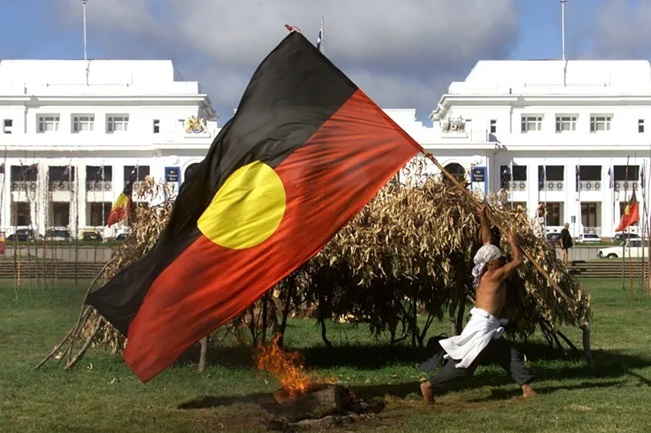‘Indigenous Australian’ is a very general term that covers two very distinct cultural groups: Aboriginal and Torres Strait Islander peoples. These terms of grouping are umbrella terms, within which sits a large array of different nations, each with its own culture, language, beliefs, practices as well as flags. The Australian Aboriginal Flag and Torres Strait Islander Flag were designed in the 1970s and 1990s and were respectively proclaimed flags of Australia under section 5 of the Flags Act 1953 on 14 July 1995. Both are proudly displayed around Australia today.
The Australian Aboriginal Flag

Show your love for your country with an authentic Aboriginal Australia flag. The Aboriginal flag was originally raised on National Aborigines’ Day, July 9, 1971, at Victoria Square in Adelaide. It was also utilised at Canberra’s Aboriginal Tent Embassy in 1972. It was designed by Harold Joseph Thomas, a Northern Territory-based Aboriginal artist. On January 25, 2022, the Prime Minister stated that Harold Joseph Thomas’ copyright for the Australian Aboriginal Flag had been transferred to the Commonwealth of Australia.
The flag, created in proportions close to one to two, is divided horizontally into equal halves of black (top) and red (bottom), with a yellow circle in the centre. The black signifies Aboriginal people, the red represents the earth, the pigment ochre used in Aboriginal ceremonies, and the yellow circle represents the sun, the eternal renewer of life.
The flag is flown or exhibited permanently in Aboriginal centres across Australia. It is widely acknowledged as the flag of Australia’s Aboriginal peoples. The flag is protected by copyright and may only be reproduced in compliance with the Copyright Act of 1968. Carroll & Richardson-Flagworld Pty Ltd is the official licenced maker and supplier of the Aboriginal Flag on flags, pennants, banners, and bunting. The Commonwealth, as the owner of the copyright in the Aboriginal Australia flag design, allows the people to freely replicate the design in all other mediums.
The Torres Strait Islander Flag
The Torres Strait Islander Flag was accepted in May 1992 during the Torres Strait Islands Cultural Festival. Its origins are traced back to the late Mr Bernard Namok of Thursday Island.
The flag features three horizontal panels: green at the top and bottom, and blue in the middle. The panels are separated by thin black lines. The colours green, blue, and black represent the land, the sea, and the people.
In the centre of the flag is a white Dhari (traditional headgear), which represents all Torres Strait Islanders. Under the Dhari is a white five-pointed star, with the five points representing the Torres Strait Island groupings and the white representing peace. The star is a significant emblem for nautical people. The flag represents the unity and identity of all Torres Strait Islander peoples of Australia. The flag is copyright protected and may only be reproduced in compliance with the Copyright Act 1968 or with the Torres Strait Island Regional Council’s permission.
How to Pick an Authentic Flag: Important Buying Factors
Not all Aboriginal flags and Torres Strait Islander flags on the market are created equal. To help you pick an authentic one, there are some important factors to keep in mind when buying.
Fabrics and Location
Perhaps nylon is one of the most common materials used for flags. Because they are made of lightweight materials, nylon flags have specific advantages over other flag materials, such as the ability to fly in weaker winds. Furthermore, when compared to other textiles, nylon flags are brighter and more vibrant, making your flag stand out. Even better, nylon dries quickly and can withstand a wide range of weather conditions, including the worst.
Polyester, on the other hand, is one of the most durable materials available for making flags these days. As a result, polyester flags are typically made from a durable 2-ply polyester material, which is a luxurious fabric with brilliant, fade-resistant colours. They also feature an open weave, which improves their flight and wind resistance.
Traditional cotton flags are also available and make excellent choices for indoor and outdoor memorial displays. The bulk of these flags are composed of a durable two-ply cotton weave. Some flags feature rich, vibrant colours, making them ideal for display.
Size
The quality of the layers and borders can disclose a lot about the flag’s condition. Before purchasing a flag, keep these two points in mind. Unlike ensigns, the location from which flags will be flown has a considerable impact on the size of the flag you should purchase at any particular time. Flags intended for cars and those to be hung inside your home, for example, are typically smaller than flags exhibited outdoors.
When it comes to outdoor use, ensure sure the size you are looking for is compatible with the flagpole you are using. If you are confused about the size and height blends, you can always ask the merchant from which you purchased your flag for references.
























